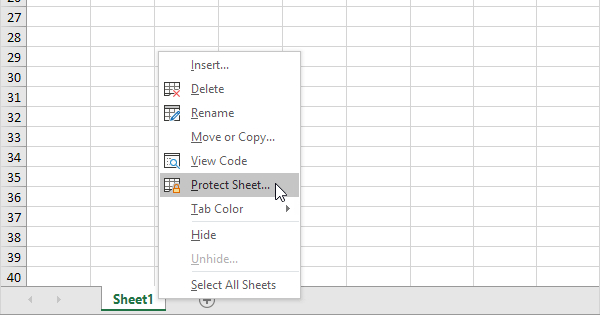5 Easy Ways to VBA Protect Excel Sheets

Microsoft Excel is one of the most powerful tools for data manipulation and management available today. Whether you're handling sensitive financial data, managing inventory, or just keeping personal records, protecting your Excel sheets is crucial. Visual Basic for Applications (VBA) in Excel allows for advanced customization, including sheet protection. Here are five easy ways to utilize VBA to protect your Excel sheets securely.
VBA Code to Set Sheet Password

The simplest form of protection is setting a password to view or modify the sheet. Here’s how you can do it:
Sub ProtectSheet()
‘ Set the password for the active sheet
ActiveSheet.Protect Password:=“YourPasswordHere”, DrawingObjects:=True, Contents:=True, Scenarios:=True
End Sub
- Active Sheet Protection: This code snippet uses VBA to protect the currently active sheet with a password.
- Change
YourPasswordHereto whatever password you choose. - Use
ActiveSheet.Unprotect Password:=“YourPasswordHere”to unprotect the sheet when needed.
🔑 Note: Remember your password. If you forget it, you’ll need to manually unprotect the sheet, which can be cumbersome.
Protect Specific Ranges or Cells

Sometimes, you might need to allow users to edit certain cells while protecting others:
Sub ProtectRange()
’ Lock specific ranges
With Worksheets(“Sheet1”)
.Range(“A1:A10”).Locked = False
.Protect Password:=“YourPasswordHere”
End With
End Sub
- Protecting Specific Cells: This script locks all cells by default except for the range specified, here from A1 to A10.
- This method is particularly useful when you need collaboration on parts of the sheet.
VBA for Worksheet Object Protection

To ensure that users can’t manipulate the worksheet’s structure:
Sub ProtectStructure()
ActiveWorkbook.Protect Password:=“StructurePass”, Structure:=True
End Sub
- Structure Protection: This prevents users from adding, deleting, hiding, or unhiding sheets in the workbook.
- Unprotecting: Use
ActiveWorkbook.Unprotect Password:="StructurePass"to allow changes to the workbook structure.
⚙️ Note: Workbook and worksheet protection can coexist but require separate passwords for full functionality.
Protect VBA Code

If you want to prevent others from viewing or modifying your VBA code:
Sub ProtectProjectCode()
With ThisWorkbook.VBProject
.Protection = vbext_pp_locked
.Password = “ProjectCodePass”
End With
End Sub
- This code locks down the project with a password, making it difficult to edit or steal your VBA scripts.
Advanced Protection Techniques

For those looking for robust security, consider these advanced methods:
- Event-Driven Protection: Use VBA events like Worksheet_Activate or Workbook_Open to automatically protect sheets when the workbook is opened or specific sheets are activated.
- Data Encryption: While not a VBA function, encrypting the Excel file itself provides another layer of security. You can do this manually or via VBA by modifying file properties.
In summary, using VBA to protect your Excel sheets can significantly enhance the security of your data. From simple password protection to complex event-driven safeguarding, these methods cater to various levels of security needs. Remember, while these techniques offer strong protection, the best security is often a combination of technical measures and good practices like backing up data and maintaining confidentiality with passwords.
Can I protect sheets based on user roles in VBA?

+
Yes, you can utilize VBA to apply protection based on user roles. Here’s a simple approach:
Create User Roles: Define roles with their respective access levels in VBA.
Check User Identity: Use functions like
Environ("username")to check the current user’s identity.Apply Protection: Tailor sheet protection based on the role:
Sub ApplyRoleProtection()
Dim userName As String
userName = Environ(“username”)
If userName = “Admin” Then
‘ Admin has full control
Sheets(“DataEntry”).Unprotect Password:=“AdminPass”
ElseIf userName = “RegularUser” Then
’ Only specific cells are editable
With Sheets(“DataEntry”)
.Range(“B2:D100”).Locked = False
.Protect Password:=“UserPass”
End With
End If
End Sub
What are the risks associated with protecting sheets with VBA?

+
Here are some risks to consider:
Password Vulnerabilities: If your passwords are weak, they can be easily cracked, undermining your security measures.
MACROS Malware: VBA can introduce macro-enabled files which, if not from a trusted source, might contain harmful macros.
Lost Passwords: Forgetting passwords means you’ll need to use manual unprotection or third-party tools, which could result in data loss.
Limited Protection: VBA sheet protection can be bypassed by advanced users or through Excel’s built-in features.
Is it possible to protect the workbook with VBA?

+
Yes, you can protect the entire workbook with VBA using the Protect method on ActiveWorkbook. Here’s how:
Sub ProtectWorkbook()
ActiveWorkbook.Protect Password:="WorkbookPass", Structure:=True, Windows:=False
End Sub
This command protects the workbook structure and window positions, ensuring no one can modify sheets, add or delete sheets, or change the view or size of the workbook window.



